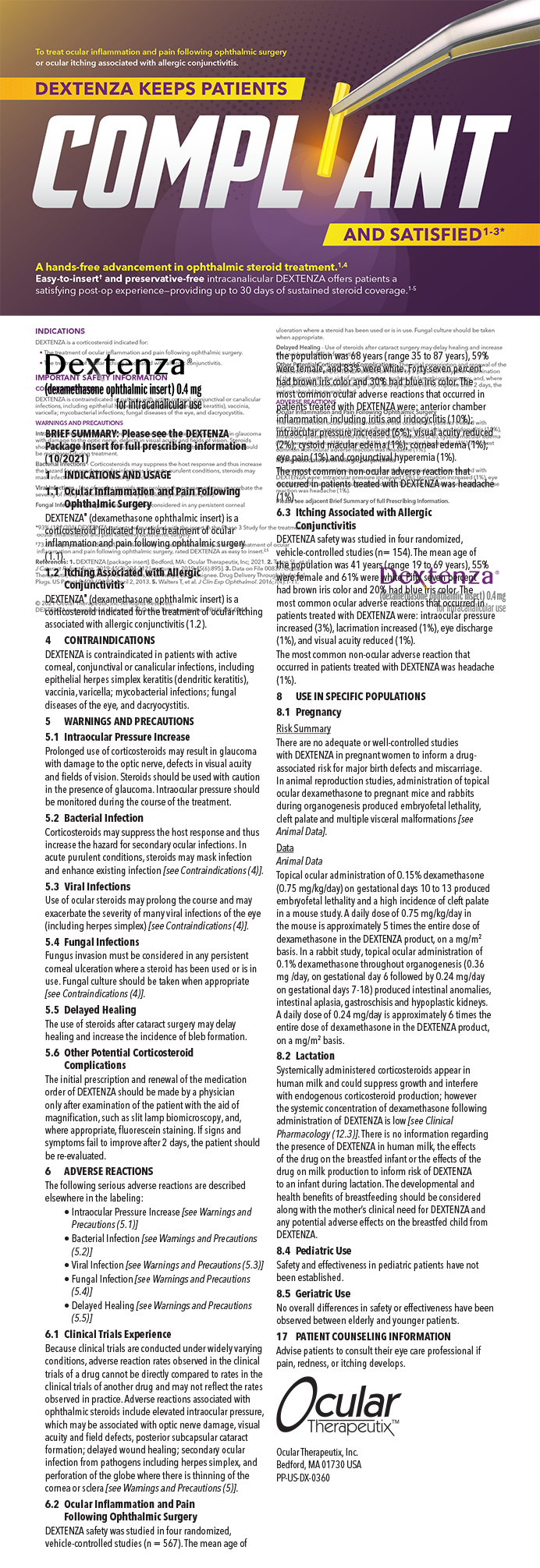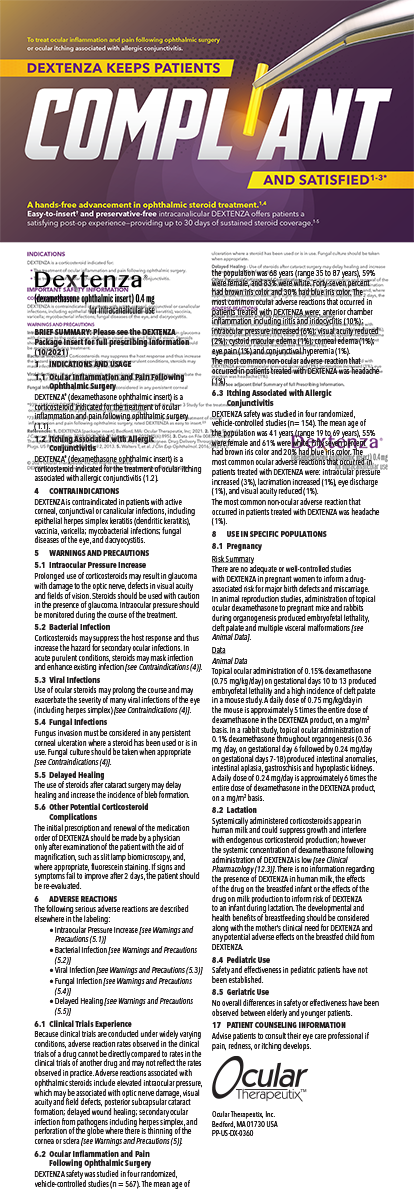
Risk Factors and Incidence of Macular Edema After Cataract Surgery: a Database Study of 81,984 Eyes
Chu CJ, Johnston RL, Buscombe C, et al; United Kingdom Pseudophakic Macular Edema Study Group1
ABSTRACT
This is a retrospective case series review of almost 82,000 cataract surgeries in the United Kingdom over a 4-year period. The investigators analyzed data from the mandatory electronic medical record (EMR) system used in eight independent clinic sites participating in the British National Health Service from December 2010 through December 2014. The primary outcome measure was a diagnosis of pseudophakic cystoid macular edema (CME) or new onset of macular edema in a diabetic patient within 90 days of cataract surgery. Only 698 patients who were considered at high risk of CME received perioperative prophylactic topical nonsteroidal anti-inflammatory drugs (NSAIDs), and they were excluded from analysis. Patients with multiple copathologies (other than amblyopia and diabetes) were also excluded, as were patients who had combined surgical procedures and those with diabetes and prior macular edema.
AT A GLANCE
- A retrospective case series review of almost 82,000 cataract surgeries in the United Kingdom over a 4-year period found a significantly increased relative risk of cystoid macular edema (CME) with the presence of an epiretinal membrane, previous retinal vein occlusion, uveitis, previous retinal detachment repair, and the occurrence of posterior capsule rupture (PCR). Diabetes without retinopathy had a significantly increased risk of CME that rose linearly based on the severity of retinopathy. Preoperative prostaglandin use, high myopia, and dry age-related macular degeneration were not associated with a statistically significantly higher risk of CME.
- In a retrospective, multicenter, national electronic medical record database study of 65,836 eyes of 44,635 patients in the United Kingdom undergoing cataract surgery, the risk of PCR was 2.59 times higher after 10 or more prior intravitreal injections compared with baseline. The increased risk of PCR after a single injection was small.
- A retrospective case series of 61,907 eyes of 46,824 patients undergoing cataract surgery in the United Kingdom found the median time to pseudophakic retinal detachment surgery to be 44 days after cataract surgery complicated by PCR.
The analysis identified a study cohort of almost 16,000 cases with only a single risk factor for CME. Approximately 4,500 of these patients were diabetic. The study group was compared to a reference cohort of more than 35,000 cases in nondiabetic patients with no copathology and no surgical complications. The potential CME risk factors analyzed were diabetes (with or without retinopathy), epiretinal membrane, preoperative prostaglandin use, prior retinal vein occlusion, previous retinal detachment (RD), uveitis, dry age-related macular degeneration (AMD), high myopia, or posterior capsule rupture (PCR; with or without vitreous loss) during surgery.
Results showed an overall 1.17% rate of CME. The relative risk (RR) for CME increased significantly with the presence of an epiretinal membrane (RR 5.60), previous retinal vein occlusion (RR 4.47), uveitis (RR 2.88), previous RD repair (RR 3.93), and the occurrence of PCR (RR 2.61). Diabetes without retinopathy had a significantly increased risk of CME (RR 1.80), and it rose linearly based on the severity of retinopathy up to an RR of 10.3 for proliferative diabetic retinopathy. The other preselected potential risk factors (preoperative prostaglandin use, high myopia, and dry AMD) were not associated with a statistically significantly higher risk of CME.
DISCUSSION
This is one of the largest studies to examine pseudophakic CME in a real-world clinical setting, enabled by the structured recording of health information from an EMR system in daily use. As this “big data” reporting in ophthalmology becomes more commonplace around the world, including the American Academy of Ophthalmology’s Intelligent Research in Sight (IRIS) registry in the United States,2 more studies of this magnitude yielding valuable information for clinicians can be expected.
The baseline pseudophakic CME rate of 1.17% for nondiabetics without risk factors in this study is similar to that reported in other recent, smaller, prospective studies.3,4 With diabetes, the CME rate increased to 4.04%, similar to that reported in another study.5 This is the largest study of pseudophakic CME in diabetics, however, with almost 4,500 cases, including stratification by Early Treatment Diabetic Retinopathy Study (ETDRS) grade of retinopathy.1
Because prophylactic NSAIDs are commonly used in the United States but were not here, this study may overstate the risk of CME compared to current standard practice. Underreporting is also somewhat likely, because routine optical coherence tomography and intravenous fluorescein angiography were not performed unless CME was suspected based on clinical examination or decreased visual acuity. Patients were commonly seen only once at 4 to 6 weeks postoperatively, often by a nurse or community optometrist, so mild cases of CME that resolved without treatment might have been missed.1
The impact of CME on visual acuity is significant, so preoperative counseling of patients at increased risk along with preventive treatment is crucial. A previous meta-analysis of studies evaluating topical steroids and nonsteroidal agents for CME found a reduced final visual acuity in eyes with pseudophakic CME.6 In this study, too, a significant reduction in final visual acuity up to 24 weeks after surgery occurred for the 415 eyes with CME compared to 35,146 eyes without CME (logMAR 0.4 vs 0.2).1
Interestingly, whereas previous smaller studies showed an association of CME with prostaglandin use,7,8 this study including 3,394 eyes in that category found no increased risk for CME as an isolated risk factor. This should be sufficient evidence that, in the absence of other risk factors for CME, topical prostaglandin analogues do not have to be routinely suspended at the time of cataract surgery.
This is very useful research for cataract surgeons, because it allows targeted prophylaxis and increased surveillance for CME primarily in the high-risk groups identified. Use of postoperative NSAIDs and optical coherence tomography screening mainly in these groups is more cost-effective than universal preventive measures for a complication that occurs in only 1:100 cases on average without identifiable preoperative risk factors.
Previous Intravitreal Therapy Is Associated With Increased Risk of Posterior Capsule Rupture During Cataract Surgery
Lee AY, Day AC, Egan C, et al; United Kingdom Age-Related Macular Degeneration and Diabetic Retinopathy Electronic Medical Records Users Group9
ABSTRACT
This is a retrospective, multicenter, national EMR database study of 65,836 eyes of 44,635 patients in the United Kingdom undergoing cataract surgery between 2004 and 2014 at 20 hospitals using the same EMR system. The main outcome measure was the presence or absence of PCR during surgery. The purpose was to investigate if previous intravitreal therapy is a predictor of PCR during cataract surgery.
In univariate regression analyses, patient’s age, advanced cataract, junior cataract surgeon grade, and number of previous intravitreal injections were all significant predictors of PCR. Repeat categorical analysis showed that 10 or more previous injections were associated with a 2.59 times higher likelihood of PCR (P = .003) after adjusting for the other significant independent predictors of PCR: patient’s age, advanced cataract, and cataract surgeon’s experience.
DISCUSSION
This study is the first to elucidate previous intravitreal injection as a risk factor for PCR during cataract surgery. Prior case reports have documented damage to the lens capsule as a complication of intravitreal injection, but this is uncommon.10 Patients who rapidly developed a mature or white cataract after an injection, indicating possible lens trauma, were excluded from this study.
The increased risk of PCR after a single injection was small, but for patients with 10 or more prior injections, the risk of PCR was about 2.6 times higher than baseline.9 This study was not able to differentiate by injected medication, because the large majority was given antivascular endothelial growth factor agents. Interestingly, the risk was not higher when the prior injection was given by a trainee surgeon versus more experienced staff, but a history of any prior intravitreal injection by a nurse, which is fairly common in the United Kingdom,11 resulted in a two times greater likelihood of PCR. This finding could indicate that variation in injection technique may result in undetected damage to the lens capsule or zonular apparatus.
To put the 2.6 times higher risk of PCR after intravitreal injection found in this study into perspective, one can consider that the odds ratio for PCR with other known risk factors (including brunesent/white cataract, systemic a-antagonist use, pseudoexfoliation syndrome, a small pupil, and age > 80 years) have all been documented to be between 1.5 and 3 times higher.12 A patient with a history of 10 or more intravitreal injections therefore has about the same elevated risk of PCR during cataract surgery as someone with pseudoexfoliation or a dense, mature cataract. This information should help cataract surgeons prepare and appropriately counsel their patients with wet AMD who have received multiple antivascular endothelial growth factor injections.
United Kingdom National Ophthalmology Database Study of Cataract Surgery
Report 3: Pseudophakic Retinal Detachment
Jaycock P, Johnston RL, Taylor H, et al13
ABSTRACT
This study is a retrospective case series of 61,907 eyes of 46,824 patients undergoing cataract surgery between October 2006 and August 2010 in the United Kingdom. The investigators reviewed records in the National Ophthalmology Database from 13 sites where both cataract and vitreoretinal surgery were coded on the same EMR system. The outcome measure was time to pseudophakic RD after cataract surgery with PCR. Analyses were restricted to cases with at least 3 months of follow-up.
Pseudophakic RD surgery was performed on 131 eyes of 129 patients. Of these procedures, 36 were in eyes that suffered a PCR during cataract surgery (3.27%), and 95 were in eyes that did not have a PCR (0.16%). The 1-, 2-, and 3-year Kaplan-Meier rates for pseudophakic RD were 0.30%, 0.81%, and 1.06% for eyes that did not experience PCR and 4.22%, 8.63%, and 12.07% for eyes with PCR, respectively. For eyes that progressed to RD surgery, the median time to pseudophakic RD surgery was 44 days for eyes with PCR and 6.3 months for eyes without PCR.14
DISCUSSION
The incidence of PCR during cataract surgery varies widely with surgeons’ experience and patients’ risk factors, but it has been shown to occur on average in about 2% of cataract operations.13,15,16 PCR with or without vitreous loss is a known risk factor for pseudophakic RD.16-20 In two recent studies,16,18 the odds ratios for RD after PCR were 15 times higher within 3 years and 42 times higher within 3 months than if PCR had not occurred. Data from another recent population study estimated an adjusted hazard ratio of 27.6 at 5 years for RD after PCR.19
This study investigated time to pseudophakic RD after PCR to provide guidance on optimal postoperative surveillance and counseling for patients with PCR. The investigators found not only that RD was more likely after cataract surgery complicated by PCR, as in other studies, but also that, when RD occurred, it was much sooner after PCR on average.
As a nonselected large population analysis from pooled data, this study is less likely to suffer from selection bias than a single-center study. Some underreporting is possible if patients with RD were treated as an emergency at another site.
With RD occurring on average less than 2 months after cataract surgery complicated by PCR, it is prudent for eye care providers to perform a careful dilated fundus examination of these patients’ eyes well before 3 months postoperatively or even to refer them routinely to a vitreoretinal specialist early in the postoperative course for increased surveillance, which would allow immediate prophylactic treatment of any retinal breaks discovered.
1. Chu CJ, Johnston RL, Buscombe C, et al; United Kingdom Pseudophakic Macular Edema Study Group. Risk factors and incidence of macular edema after cataract surgery: a database study of 81984 eyes. Ophthalmology. 2016;123(2):316-323.
2. Parke DW, Lum F, Rich WL. The IRIS Registry: purpose and perspectives [in German]. Ophthalmologe. 2016;113(6):463-468.
3. Henderson BA, Kim JY, Ament CS, et al. Clinical pseudophakic cystoid macular edema. J Cataract Refract Surg. 2007;33:1550-1558.
4. Packer M, Lowe J, Fine H. Incidence of acute postoperative cystoid macular edema in clinical practice. J Cataract Refract Surg. 2012;38:2108-2111.
5. Brito PN, Rosas VM, Coentrão LM, et al. Evaluation of visual acuity, macular status, and subfoveal choroidal thickness changes after cataract surgery in eyes with diabetic retinopathy. Retina. 2015;35:294-302.
6. Kessel L, Tendal B, Jørgensen KJ, et al. Post-cataract prevention of inflammation and macular edema by steroid and nonsteroidal anti-inflammatory eye drops: a systematic review. Ophthalmology. 2014;121:1915-1924.
7. Moroi SE, Gottfredsdottir MS, Schteingart MT, et al. Cystoid macular edema associated with latanoprost therapy in a case series of patients with glaucoma and ocular hypertension. Ophthalmology. 1999;106:1024-1029.
8. Warwar RE, Bullock JD, Ballal D. Cystoid macular edema and anterior uveitis associated with latanoprost use. Experience and incidence in a retrospective review of 94 patients. Ophthalmology. 1998;105:263-268.
9. Lee AY, Day AC, Egan C, et al; United Kingdom Age-related Macular Degeneration and Diabetic Retinopathy Electronic Medical Records Users Group. Previous intravitreal therapy is associated with increased risk of posterior capsule rupture during cataract surgery. Ophthalmology. 2016;123(6):1252-1256.
10. Jonas JB, Spandau UH, Schlichtenbrede F. Short-term complications of intravitreal injections of triamcinolone and bevacizumab. Eye. 2008;22:590-591.
11. DaCosta J, Hamilton R, Nago J, et al. Implementation of a nurse-delivered intravitreal injection service. Eye (Lond). 2014;28:734-740.
12. Narendran N, Jaycock P, Johnston RL, et al. The Cataract National Dataset electronic multicentre audit of 55,567 operations: risk stratification for posterior capsule rupture and vitreous loss. Eye (Lond). 2009;23(1):31-37.
13. Jaycock P, Johnston RL, Taylor H, et al. The Cataract National Dataset electronic multi-centre audit of 55,567 operations: updating benchmark standards of care in the United Kingdom and internationally. Eye (Lond). 2009;23:38-49.
14. Day AC, Donachie PH, Sparrow JM,Johnston RL; Royal College of Ophthalmologists’ National Ophthalmology Database. United Kingdom National Ophthalmology Database Study of Cataract Surgery: report 3: pseudophakic retinal detachment. Ophthalmology. 2016;123(8):1711-1715.
15. Lundström M, Behndig A, Kugelberg M, et al. Decreasing rate of capsule complications in cataract surgery: eight-year study of incidence, risk factors, and data validity by the Swedish National Cataract Register. J Cataract Refract Surg. 2011;37:1762-1767.
16. Day AC, Donachie PHJ, Sparrow JM, Johnston RL; Royal College of Ophthalmologists’ National Ophthalmology Database. The Royal College of Ophthalmologists’ National Ophthalmology Databas study of cataract surgery: report 1, visual outcomes and complications. Eye (Lond). 2015;29(4):552-560.
17. Tuft SJ, Minassian D, Sullivan P. Risk factors for retinal detachment after cataract surgery: a case-control study. Ophthalmology. 2006;113:650-656.
18. Jakobsson G, Montan P, Zetterberg M, et al. Capsule complication during cataract surgery: retinal detachment after cataract surgery with capsule complication: Swedish Capsule Rupture Study Group report 4. J Cataract Refract Surg. 2009;35(10):1699-1705.
19. Clark A, Morlet N, Ng JQ, et al. Risk for retinal detachment after phacoemulsification: a whole-population study of cataract surgery outcomes. Arch Ophthalmol. 2012;130:882-888.
20. Daien V, Le Pape A, Heve D, et al. Incidence, risk factors, and impact of age on retinal detachment after cataract surgery in France: a national population study. Ophthalmology. 2015;122:2179-2185.




